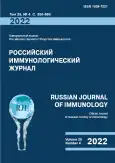Features of humoral immunity in patients with mild traumatic brain injury
- Authors: Norka A.O.1,2, Vorobyev S.V.3, Kuznetsova R.N.1,2, Serebriakova M.K.4, Kudryavtsev I.V.1,4, Kovalenko S.N.5, Monashenko D.N.6, Korobova Z.R.1,2
-
Affiliations:
- First St. Petersburg State I. Pavlov Medical University
- St. Petersburg Pasteur Research Institute of Epidemiology and Microbiology
- V. Almazov National Medical Research Centre
- Institute of Experimental Medicine
- S. Kirov Military Medical Academy
- St. Petersburg City Hospital No. 26
- Issue: Vol 25, No 4 (2022)
- Pages: 471-476
- Section: SHORT COMMUNICATIONS
- URL: https://journals.rcsi.science/1028-7221/article/view/120091
- DOI: https://doi.org/10.46235/1028-7221-1182-FOH
- ID: 120091
Cite item
Full Text
Abstract
Traumatic brain injury (TBI) is an important problem of the healthcare system. A lPeading role in pathogenesis belongs to the action of shock wave upon skull and brain integuments, extending from the impacted site, as well as displacement and rotation of the cerebral hemispheres relative to the fixed brain stem. As a result, a cascade of metabolic, biochemical and inflammatory changes is initiated, leading to secondary damage. TBI, depending on its mechanism, severity and type, causes various primary structural and functional brain lesions at molecular, cellular, tissue and organ levels with dysregulation of all systems in the body, dependent on its degree and extent. In most cases, the brain injury increases the risk of developing epilepsy and neurodegenerative diseases such as Alzheimer’s disease, arkinson’s disease and chronic traumatic encephalopathy (CTE), with mental health disorders. TBI is a long-term symptomatic process in patients with functional and structural damage. In response to a traumatic event, the damage-associated molecular patterns (DAMPs) encountered upon tissue damage are expressed, which cause activation of the resident brain tissue cells, and secretion of multiple chemokine and cytokine by distinct cell populations. Neutrophils migrate to focal lesions, which remove damaged cells and debris. Migration of T and B cells is observed 3-7 days after the trauma. Hence, following primary injury, due to a cascade of immune reactions, a more extensive lesion, the so-called secondary trauma, is developed. The aim of our study was to evaluate the role of immune response in pathogenesis of mild traumatic brain injury.
An increased number of Bm2 cells, IgDdimCD27low “naive” B cells and B cells with the IgDlowCD27hi (“plasmablasts”) phenotype was found in patients with mild brain contusion, compared to comparison group. Moreover, the number of “naive” mature B cells with the CD27lowCD38dim phenotype was significantly decreased compared with the controls.
Full Text
##article.viewOnOriginalSite##About the authors
Anna O. Norka
First St. Petersburg State I. Pavlov Medical University; St. Petersburg Pasteur Research Institute of Epidemiology and Microbiology
Author for correspondence.
Email: norka-anna@mail.ru
Senior Laboratory Assistant, Department of Immunology; Neurologist, Medical Centre
Russian Federation, St. Petersburg; St. PetersburgS. V. Vorobyev
V. Almazov National Medical Research Centre
Email: norka-anna@mail.ru
PhD, MD (Medicine), Chief Research Associate, Research Laboratory of Neurology and Neurorehabilitation
Russian Federation, St. PetersburgR. N. Kuznetsova
First St. Petersburg State I. Pavlov Medical University; St. Petersburg Pasteur Research Institute of Epidemiology and Microbiology
Email: norka-anna@mail.ru
PhD (Medicine), Associate Professor, Department of Immunology; Allergist-Immunologist, Medical Centre
Russian Federation, St. Petersburg; St. PetersburgM. K. Serebriakova
Institute of Experimental Medicine
Email: norka-anna@mail.ru
Postgraduate Student, Research Associate, Department of Immunology
Russian Federation, St. PetersburgI. V. Kudryavtsev
First St. Petersburg State I. Pavlov Medical University; Institute of Experimental Medicine
Email: norka-anna@mail.ru
PhD (Biology), Senior Research Associate, Department of Immunology; Associate Professor, Department of Immunology
Russian Federation, St. Petersburg; St. PetersburgS. N. Kovalenko
S. Kirov Military Medical Academy
Email: norka-anna@mail.ru
Lecturer, Department of Neurosurgery
Russian Federation, St. PetersburgD. N. Monashenko
St. Petersburg City Hospital No. 26
Email: norka-anna@mail.ru
PhD (Medicine), Neurosurgeon
Russian Federation, St. PetersburgZ. R. Korobova
First St. Petersburg State I. Pavlov Medical University; St. Petersburg Pasteur Research Institute of Epidemiology and Microbiology
Email: norka-anna@mail.ru
Laboratory Researcher, Laboratory of Molecular Immunology; Senior Laboratory Assistant, Department of Immunology
Russian Federation, St. Petersburg; St. PetersburgReferences
- Кудрявцев И.В., Субботовская А.И. Опыт измерения параметров иммунного статуса с использованием шестицветного цитофлуоримерического анализа // Медицинская иммунология, 2015. T. 17, № 1. С. 19-26. [Kudryavtsev I.V., Subbotovskaya A.I. Application of six-color flow cytometric analysis for immune profile monitoring. Meditsinskaya immunologiya = Medical Immunology (Russia), 2015, Vol. 17, no. 1, pp. 19-26. (In Russ.)] doi: 10.15789/1563-0625-2015-1-19-26.
- Лихтерман Л.Б. Черепно-мозговая травма. Диагностика и лечение. М.: ГЭОТАР-Медиа, 2014. 488 с. [Lichterman L.B. Traumatic brain injury. Diagnosis and treatment]. Moscow: GEOTAR-Media, 2014. 488 p.
- Потапов А.А., Лихтерман Л.Б., Кравчук А.Д., Корниенко В.Н., Захарова Н.Е., Ошоров А.В., Филатов М.М. Современные подходы к изучению и лечению черепно-мозговой травмы // Анналы клинической и экспериментальной неврологии, 2010. Т. 4, № 1. С. 4-12. [Potapov A.A., Likhterman L.B., Kravchuk A.D., Kornienko V.N., Zakharova N.E., Oshorov A.V., Filatova M.M. Modern approaches to the management of traumatic brain injury. Annaly klinicheskoy i eksperimentalnoy nevrologii = Annals of Clinical and Experimental Neurology, 2010, Vol. 4, no. 1, pp. 4-12. (In Russ.)]
- Хайдуков С.В., Байдун Л.А., Зурочка А.В., Тотолян Арег А., Хайдуков С.В. Стандартизованная технология «исследование субпопуляционного состава лимфоцитов периферической крови с применением проточных цитофлюориметров-анализаторов» (проект) // Медицинская иммунология, 2012. Т. 14, № 3. С. 255-268. [Khaydukov S.V, Baidun L.A., Zurochka A.V., Totolyan Areg A. Standardized technology “Study of the subpopulation composition of peripheral blood lymphocytes using flow cytofluorometer-analyzers” (project). Meditsinskaya immunologiya = Medical Immunology (Russia), 2012, Vol. 14, no. 3, pp. 255-268. (In Russ.)] doi: 10.15789/1563-0625-2012-3-255-268.
- Dantzer R., O’Connor J.C., Freund G.G., Johnson R.W., Kelley K.W. From inflammation to sickness and depression: when the immune system subjugates the brain. Nat. Rev. Neurosci., 2008, Vol. 9, no. 1, pp. 46-56.
- McKee C.A., Lukens J.R. Emerging roles for the immune system in traumatic brain injury. Front. Immunol., 2016, Vol. 7, 556. doi: 10.3389/fimmu.2016.00556.
- Nizamutdinov D., Shapiro L.A. Overview of traumatic brain injury: an immunological context. Brain Sci., 2017, Vol. 7, no. 1, 11. doi: 10.3390/brainsci7010011.
- Prak E.T.L., Ross J., Sutter J., Sullivan K.E. Age-related trends in pediatric B-cell subsets. Pediatr. Dev. Pathol., 2011, Vol. 14, no. 1, pp. 45-52.
Supplementary files







